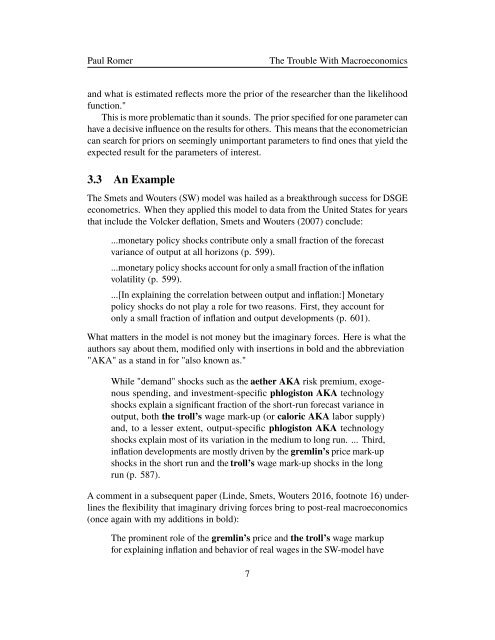The Trouble With Macroeconomics
eziYxDX
eziYxDX
You also want an ePaper? Increase the reach of your titles
YUMPU automatically turns print PDFs into web optimized ePapers that Google loves.
Paul Romer<br />
<strong>The</strong> <strong>Trouble</strong> <strong>With</strong> <strong>Macroeconomics</strong><br />
and what is estimated reflects more the prior of the researcher than the likelihood<br />
function."<br />
This is more problematic than it sounds. <strong>The</strong> prior specified for one parameter can<br />
have a decisive influence on the results for others. This means that the econometrician<br />
can search for priors on seemingly unimportant parameters to find ones that yield the<br />
expected result for the parameters of interest.<br />
3.3 An Example<br />
<strong>The</strong> Smets and Wouters (SW) model was hailed as a breakthrough success for DSGE<br />
econometrics. When they applied this model to data from the United States for years<br />
that include the Volcker deflation, Smets and Wouters (2007) conclude:<br />
...monetary policy shocks contribute only a small fraction of the forecast<br />
variance of output at all horizons (p. 599).<br />
...monetary policy shocks account for only a small fraction of the inflation<br />
volatility (p. 599).<br />
...[In explaining the correlation between output and inflation:] Monetary<br />
policy shocks do not play a role for two reasons. First, they account for<br />
only a small fraction of inflation and output developments (p. 601).<br />
What matters in the model is not money but the imaginary forces. Here is what the<br />
authors say about them, modified only with insertions in bold and the abbreviation<br />
"AKA" as a stand in for "also known as."<br />
While "demand" shocks such as the aether AKA risk premium, exogenous<br />
spending, and investment-specific phlogiston AKA technology<br />
shocks explain a significant fraction of the short-run forecast variance in<br />
output, both the troll’s wage mark-up (or caloric AKA labor supply)<br />
and, to a lesser extent, output-specific phlogiston AKA technology<br />
shocks explain most of its variation in the medium to long run. ... Third,<br />
inflation developments are mostly driven by the gremlin’s price mark-up<br />
shocks in the short run and the troll’s wage mark-up shocks in the long<br />
run (p. 587).<br />
A comment in a subsequent paper (Linde, Smets, Wouters 2016, footnote 16) underlines<br />
the flexibility that imaginary driving forces bring to post-real macroeconomics<br />
(once again with my additions in bold):<br />
<strong>The</strong> prominent role of the gremlin’s price and the troll’s wage markup<br />
for explaining inflation and behavior of real wages in the SW-model have<br />
7


